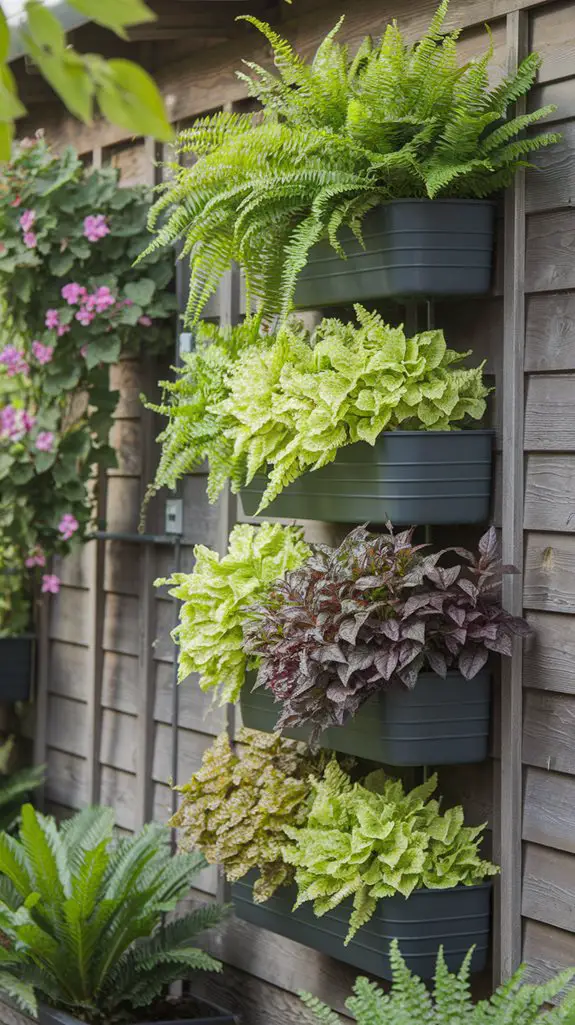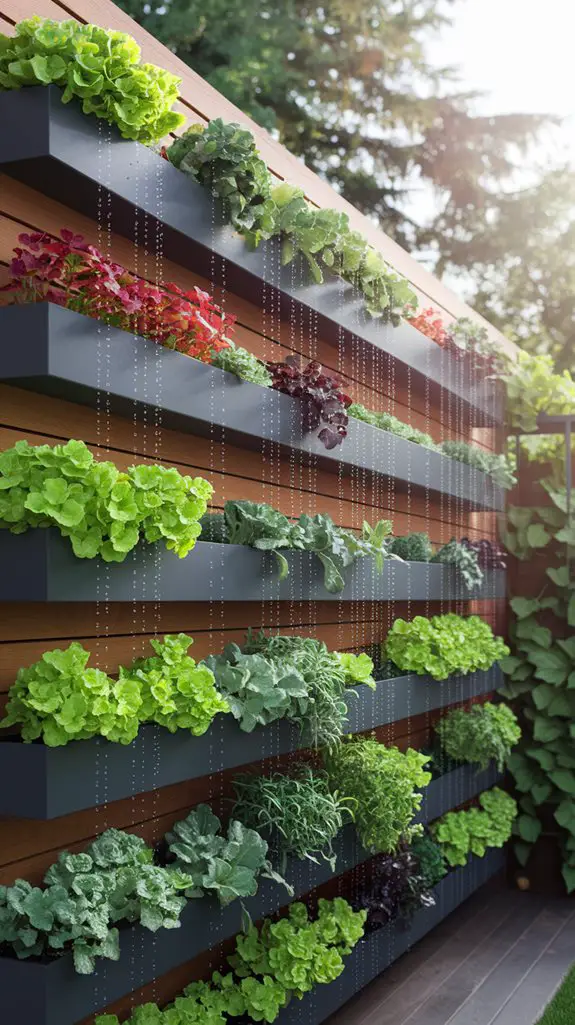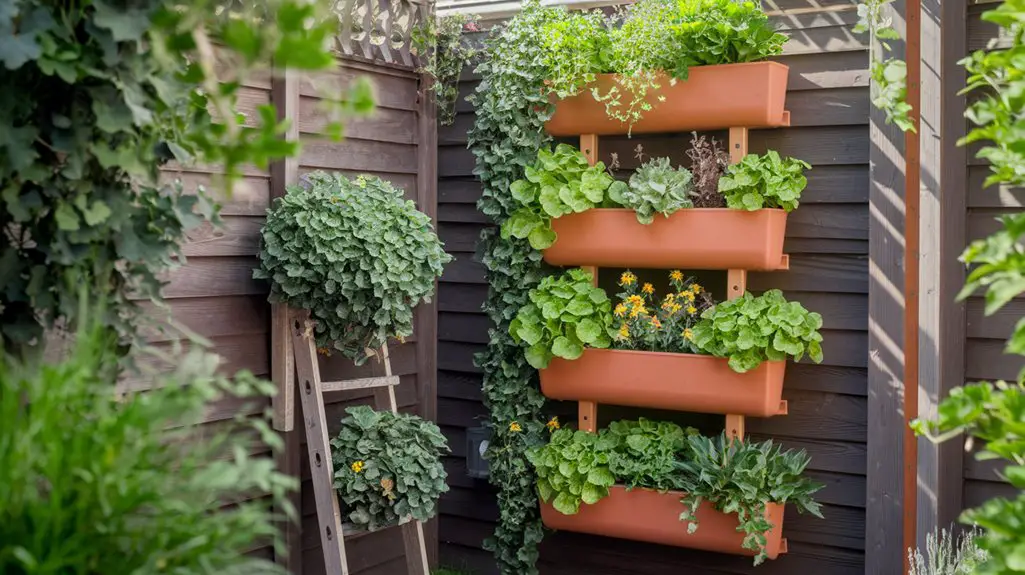Like Jack’s magical beanstalk, your small backyard holds untapped vertical potential. You don’t need acres of land to grow a thriving garden when you can build upward instead of outward. With the right structures, plant selection, and irrigation systems, your limited space can transform into a productive growing area. Discover how to maximize sunlight exposure and implement seasonal rotations that’ll keep your vertical garden flourishing all year long.
Choose the Right Vertical Structures for Your Space
The foundation of any successful vertical garden lies in selecting appropriate structures that complement your available space. For tiny patios, consider wall-mounted planters or hanging baskets that maximize vertical real estate without consuming floor space. Trellises work wonderfully against fences or walls, supporting climbing vegetables like cucumbers and beans.
If you’ve got slightly more room, freestanding tiered planters create visual interest while housing multiple plants. Repurposed pallets make excellent DIY vertical gardens for herbs and compact vegetables. For apartment dwellers, window boxes with cascading plants can transform ordinary windows into lush displays.
When selecting structures, consider weight capacity, drainage needs, and exposure to elements. Metal options provide durability but may overheat in full sun, while wood offers aesthetic appeal but requires weatherproofing. Choose materials that match your maintenance preferences. Additionally, exploring vertical gardening systems can help you identify the best solutions tailored for beginners.
Select Plants That Thrive in Vertical Gardens

Once you’ve established the perfect structural foundation, your attention must shift to populating it with suitable greenery.
Opt for lightweight, shallow-rooted varieties that won’t strain your structures. Trailing plants like pothos, string of pearls, and ivy create dramatic cascading effects, while compact herbs—thyme, oregano, and mint—thrive in vertical pockets.
For edibles, cherry tomatoes, strawberries, and leafy greens perform exceptionally well in vertical systems. Their compact growth habits maximize your limited space.
Consider each plant’s light requirements when positioning them—shade-loving ferns and hostas for north-facing walls, sun-worshipping nasturtiums and petunias for southern exposures.
Don’t overlook succulents; their minimal water needs and architectural forms make them ideal candidates for vertical installations where irrigation might be challenging. Additionally, incorporating creative vertical garden ideas can enhance the visual appeal and functionality of your space.
Master Space-Saving Irrigation Systems

Watering vertical gardens efficiently requires ingenious irrigation solutions that won’t compromise your space-saving goals.
Install a drip irrigation system with programmable timers to deliver precise water amounts directly to plant roots, preventing waste and runoff. Self-watering reservoirs built into planters can sustain plants for days, perfect for busy gardeners.
Consider these space-efficient watering options:
- Gravity-fed systems using elevated water containers connected to micro-tubing that distributes moisture evenly throughout vertical structures
- Capillary mat systems that wick water upward from a reservoir, providing consistent moisture for bottom tiers
- Misting systems with fine nozzles for delicate plants, ideal for herbs and leafy greens in confined vertical spaces
Position irrigation components behind foliage both for aesthetics and to protect plastic components from UV degradation. Additionally, implementing low-maintenance yards can further enhance the sustainability and ease of care for your vertical garden.
Maximize Sunlight Exposure in Limited Areas
Strategic placement of your vertical garden determines its success, as even limited spaces can provide sufficient sunlight when you understand light patterns. Track sunlight movement across your space throughout the day using a sun calculator app or simple observation.
South-facing walls typically receive the most sunlight, making them ideal for sun-loving crops like tomatoes and peppers.
For partially shaded areas, install reflective surfaces—white-painted walls or aluminum foil-backed panels—to redirect light toward your plants.
Consider arranging plants vertically based on their light requirements: position shade-tolerant varieties like lettuce and ferns at the bottom, while placing sun-demanding herbs and flowering plants at the top.
During seasonal changes, adjust your vertical garden’s position or install wheeled structures that you can relocate to maintain peak exposure. Additionally, utilizing vertical gardening techniques can enhance your ability to optimize light and space effectively.
Incorporate Seasonal Rotation for Year-Round Harvests
Maximizing your vertical garden’s productivity extends beyond ideal light exposure to implementing a thoughtful seasonal rotation plan.
By strategically scheduling plantings, you’ll transform your vertical space into a perpetual harvest machine regardless of the season.
Develop your rotation strategy by:
- Matching cool-weather crops (kale, spinach, peas) for spring and fall planting positions that receive moderate sun
- Reserving prime summer spots for heat-loving vegetables like tomatoes, cucumbers, and peppers
- Incorporating quick-growing crops like radishes and lettuce between longer-term plantings
Don’t let your vertical garden sit dormant during winter months.
Install cold frames or plant covers to protect cold-hardy vegetables like Brussels sprouts and winter lettuces.
Map your garden zones based on microclimates to optimize placement throughout the changing seasons. Additionally, consider using container vegetable gardening techniques to maximize your growing potential in limited space.
Conclusion
Your vertical victory is within reach with these transformative techniques. You’ll maximize minimal meters when you mount planters properly and pick appropriate plants. Implement intelligent irrigation to guarantee everything thrives without wasting water. Position plantings perfectly for ideal sunlight, and don’t forget to rotate crops seasonally. With these strategies, you’re set to cultivate a continuous cascade of greenery from a surprisingly small footprint.




